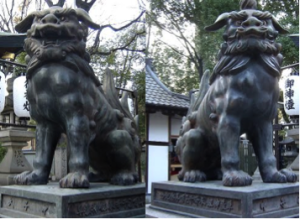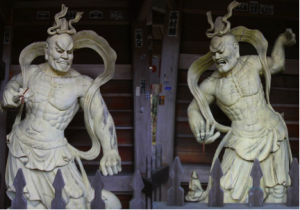A – UN (あーうん), HARMONY
 One of the prime foundation stones of the traditional Japanese Culture and modern Japan is harmony through consonance. Within the two Japanese syllables (あ, A andうん, Un) lies the infinite and meticulous details of what is underlined by that previous, simple and effortless sentence.
One of the prime foundation stones of the traditional Japanese Culture and modern Japan is harmony through consonance. Within the two Japanese syllables (あ, A andうん, Un) lies the infinite and meticulous details of what is underlined by that previous, simple and effortless sentence.
These two syllables, albeit transfers from the Chinese language with roots in Sanskrit, have gained bona fide definitions and forms within the Japanese language and society. However, one should not look for meanings in their kanjis that exist purely due to transliteration from Chinese. Hence, they are generally used with one of the phonetic alphabets, hiragana, in written Japanese.
Fashionable yoga circles and the humour that surrounds these will enable most of us to recognise the sound “Ahum”, that encapsulates religious connotations in Dharma religions that are thousands of years old such as Hinduism, Buddhism and Jainism.
The first letter of the Sanskrit alphabet (अ) is denoted by the “A” sound and is pronounced with an open mouth. The “Un”, on the other hand, is the sound of the last letter of the Sanskrit alphabet (ह) and is pronounced with a closed mouth. Contrary to the Turkish pronunciation, it gives the “nn” sound with closed lips. The Greek equivalents of these are, by and by, the first and the last letters; Alpha (A) and Omega (Ω).
Infinity and balance within the depths of human soul and spirituality is recalled by the beginning and end of the full circle of this scene. Having said that, these two sounds symbolise the origin and edge of the Universe in the Japanese Mikkyō Buddhism. We are confronted with the same “Alpha and Omega” display, imitated from the Eastern Religions, in The Book of Revelations, written in Anatolia (circa 100 AD), as an appellation of God. Same entries are further made into Islam as “The Beginning and The End / al’Awwal al’Akhir”.
 All Buddhist temples and Shinto shrines in Japan will greet you with the two guardian strongman figures (Kongōrikishi, 金剛力士 or Niō, 仁王) or animals that hybridize a lion and a dog (Komainu, 狛犬) to either side of their entrance. The guard on the right will always have an open mouth appearing to be speaking the word “A”, while the one on the left will have a closed mouth enunciating the word “Un”.
All Buddhist temples and Shinto shrines in Japan will greet you with the two guardian strongman figures (Kongōrikishi, 金剛力士 or Niō, 仁王) or animals that hybridize a lion and a dog (Komainu, 狛犬) to either side of their entrance. The guard on the right will always have an open mouth appearing to be speaking the word “A”, while the one on the left will have a closed mouth enunciating the word “Un”.
The “A” sound is the first sound we make at birth and the “Un” sound is the sound that comes with our last breath when dying. The “A” sound that is pronounced with force with an open mouth expels abominable intentions, contemptible thoughts and bad spirits. The “Un” sound with its closed lips becomes a sanctuary to commendable intentions, honourable thoughts and good spirits.
 In Japanese Culture, A-Un is used in unison with harmony, which is an essential foundation for Japan. The term “A-Un Breathing” (阿吽の呼吸 – a-un no kokyū) is used for mental and physical balance, parity, stupendous harmony, and readiness for thinking “once” and acting “once”.
In Japanese Culture, A-Un is used in unison with harmony, which is an essential foundation for Japan. The term “A-Un Breathing” (阿吽の呼吸 – a-un no kokyū) is used for mental and physical balance, parity, stupendous harmony, and readiness for thinking “once” and acting “once”.
The Sumo takes its origins from Shinto and has become the national identity card of Japanese culture for centuries. The living existence of A-Un Breathing becomes recognised. There is a lack of referee command or sound of a bell signalling the beginning of the wrestling. Instead, the Rikishi (力士, wrestlers) try and feel the right time to start through eye contact. In some instances, the “right moment” will take several minutes to come. The excitement and cheering of spectators surge as the time goes on. The wrestling begins only when the wrestlers reach that moment of harmony and unison of will and consciousness after those few seconds or several minutes of focus. And that is the moment when the A-Un Breathing captures harmony.
The Japanese use the term “A-Un Relationship” (阿吽の仲 a-un no naka) in order to express the stupendous harmony, common understanding and ingrained familiarity that identify relationships. This term underlines the understanding and convention that enables two individuals or groups to “know without talking”. Common relationship of our loving grandparents or the improvised art of two jazz musicians or the instruments and words of two poets from Anatolia are living examples of this very term.
Japan is founded on this sort of harmony, consonance and balance without which all would be impossible. For centuries, Japan is referred to as “Wa” (倭 /和) or HARMONY in one of the oldest written records from Chinese texts “Classics of Mountains and Seas” (山海經, Shan Hai Jing, circa 300 BC).
Think of a country with the name Harmony and Consonance. Now imagine this country, even in today’s world, to induce adjectives such as harmonious; as Washoku (和食) while describing the Japanese cuisine, or as Washitsu (和室) while describing Japanese living spaces and room, and many others.
I tried to, albeit with shortcomings, explain and write about how a common, everyday word as “Harmony” was allowed to become the founding principle of a whole culture and country. Unfortunately, I was not able to even touch on the reasons behind and consequences of the existence of such a word as a foundation stone.
 Without worrying about giving out any particular message, and in order to come to an end of this article, I must conclude here. I will fare well with a Haiku (originally in Turkish) that belongs to me:
Without worrying about giving out any particular message, and in order to come to an end of this article, I must conclude here. I will fare well with a Haiku (originally in Turkish) that belongs to me:
| Perfect harmonyIs in the lost momentAnd in the yearned for |
A-Un Relationship may not always be achieved simultaneously and it may last for a split second. Just like the one that has just occurred between the author of this piece and his reader.